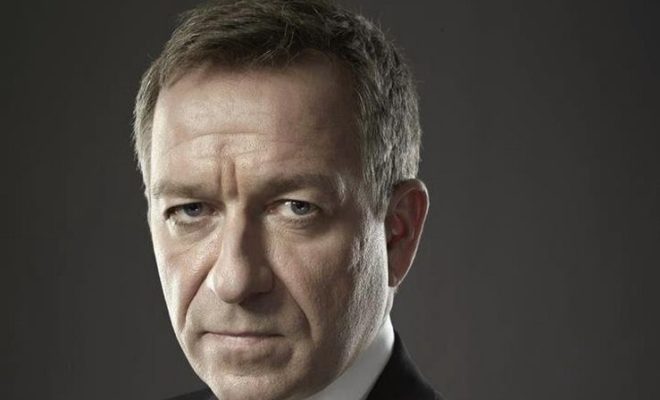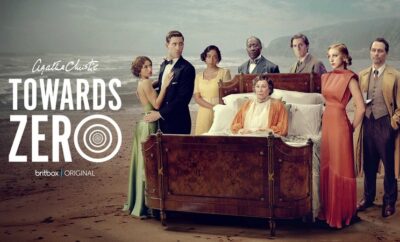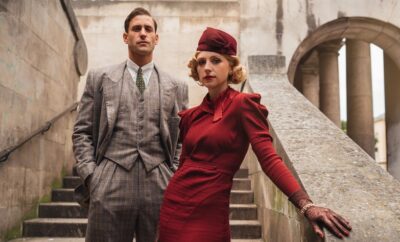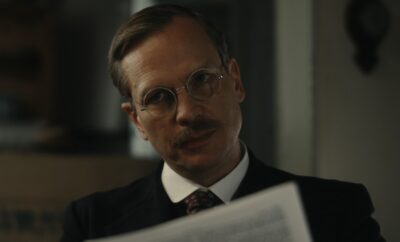
Interviews
Sean Pertwee – The Pale Horse
By: Jamie Steinberg
Q) What are the recent projects that you have been busy working on?
A) I had a very busy year after I finished I went straight on to a film called The Reckoning with Neil Marshall, who I’ve done a myriad of films with, including Dog Soldiers and Doomsday. After The Reckoning, I worked on The Pale Horse. I also came back to New York and did a series with Tom Payne called Prodigal Son. Then, I came back just prior to Christmas to do a wonderful new show with Maisie Williams called Two Weeks to Live. That’s very exciting and going to be a knockout. It’s a dark comedy. Now, the new year has started and we’re just waiting. There are a couple of brands in the fire and we’re just waiting to hear about one. So, it’s been good.
Q) What is it about Agatha Christie stories that continues to bring you back to working on them?
A) I don’t know. I’m not sure. I think it’s the Christie foundation or maybe it’s me. But it’s a real part of our entertainment background in this country. It’s just one of those things that when you see them you always wish that you were in them. It’s something that we do so well in this country – costume mysteries and dramas; I think you’d probably agree. You always see a wealth of talent in them and it is very tough to even consider turning down! You’d be green around the gills if you weren’t asked to do it. It’s like a bit of a feather in your hat. It’s one of those things you have to do.
Q) There are such incredible costumes to The Pale Horse. Does it take slipping into the period attire for you to get into character?
A) Not really, but it helps. Great Britain is an extremely old nation. A lot of our wardrobe consisted of original clothes; the majority of them are in storage. The architecture is hundreds and hundreds of years old and we shot it in Bathe (in my element). That was strange because the architecture is from the regency period and also, it’s where I went to drama school. So, it was sort of emotional for me because it was where I first started acting. You’re right, you step into the costume or step onto the set…In fact, the majority of the piece was filmed on location.
Q) Were you familiar with any of your costars before working with them on this series?
A) Well, of course I knew who Bertie Carvel was – a wonderful stage and screen actor. And Rufus Sewell was a friend of mine. Years ago, we used to hang out a great deal. So, it was wonderful seeing him again. Kaya [Scodelario] was in “Skins.” I was actually a huge fan of hers, but had never met her. We all crossed paths for the first time. Primarily Rufus, who I did most of my work with on the show. So, for me to work with him again was nothing but a joy. He’s a brilliant person to work with – irritatingly attractive and handsome. [smirks] We got on and we laughed a great deal. It was great working with him again.
Q) In this series, the cinematography is almost a character itself (as you touched on with filming in Bathe). How does that play into the series?
A) I just thought it was an original look through Leonora’s [Lonsdale] eye and Jarin [Blaschke] (who was a lighted camera man) who did some wonderful work on The Lighthouse with Willem Dafoe and Robert Pattinson. I thought it was on point in the fact that it was so surreal because it’s a confusing story to begin with and I found it sort of off-putting. It had sort of a sickly feel to it. You had someone who was always observing you. Also, it’s such a fresh spin. Sarah Phelps is such a hero to me. She’s a wonderful screenwriter and turns everything and modernizes Christie to such an end. Not just modernizes it, but puts a spin on it and makes it all relevant. So, I found the whole thing accessible and the characters accessible because The Pale Horse story is about the change in society from the old guard to modernity. It’s set during the Cuban Missile Crisis when people used to basically inherit title in our country. You’d become a Lord if your father was a Lord and you’d inherit your fortune. This was a time when everything was changing, when the youth were coming just prior to Beatniks. So, it was a really interesting, exciting time. Also, it was one of her later books so the protagonist wasn’t Poirot or Ms. Marple or any of her other characters. It was a complete outsider, who is also a dark and shady character that in many respects is the anti-hero. So, that’s what drew me to this interpretation and visualization of it – the modernity and the change of it.
Q) With such dark material, how did you shake off a long day of filming?
A) You just relax and get ready for the next day. It was a very intensive undertaking, but to be honest I was looking forward to getting back in it the next day. It was just a real pleasure to work on it so I was really looking forward to getting stuck in it. It was an extremely truncated job for me because I came straight off the back of a movie and they very kindly waited for me. When I arrived, we shot all of our sequences in less than a week. It was sort of very intense, but that’s the great thrill about our job. That’s what people call “the bug.” Once you get “the bug,” that’s what you go back for. You sort of crave that energy that you get on set. Also, being in that bubble when you’re performing with someone like Rufus and Bertie.
Q) What were some of your favorite scenes to film for the series?
A) The interrogation sequences. Some were lost because of time issues, but the interrogation sequence when I come in and basically accuse him by saying “I’m like a Junkyard Dog. I’ve got the scent of you and you smell all wrong.” In many respects, he’s right. But I can’t tip too much away because it will ruin it for the viewers. I just love the fact that he’s a real total gumshoe of a detective. He gets a whiff of this character, Mark Easterbrook (Rufus Sewell), and won’t let go. He’s a dogged character when he goes and challenges him. He’s right 90% of the way and just hasn’t quite pulled the last strands together.
Q) What do you think it is about “The Pale Horse” that makes it such a time honored and relevant series?
A) For the same reason that Agatha Christie is – it appeals to generations. It’s part of Great Britain’s DNA. I’m convinced of it. One of the things is I’d be kicked in the shin bone by my wife if I didn’t do it because when I was reading the script – like I said, to sort of breathe real life into the script when I was reading it, I read it out loud. And she said, “Don’t stop!” So, I knew it was a winner when my wife asked me to read both scripts like that [laughs]
Q) You are a part of social media. Are you looking forward to the fan feedback you’ll be receiving to the show?
A) Well, there are only two and it’s sixty minutes. Yeah, of course. I love that. That’s the great thing about our job, we get to wear different hats constantly. We are constantly moving on. It’s quite strange doing an interview now about this job because things leave you so quickly, but it was one of those ones that I’m proud of. So, of course it’s always important to hear what people have to say. It was very sort of positive and there were a lot of questions asked about this one. I love being involved in projects that challenge the audience.
Q) Is there anything else about your time on “The Pale Horse” you want to be sure we share with our readers?
A) Like I said, it was wonderful for me, personally, to be back in Bristol and the Bathe area. Bristol is where I trained and it means a great deal to me. To be going back there, literally where I used to live in Clifton (which is a beautiful part of the world), was nothing but a joy. It felt like I was sort of coming home. It was an emotional experience for me really. I loved it. I loved every minute of it.
Q) What would you like to say to everyone who are fans and supporters of you and the work you do?
A) I’d love to thank them for their unerring support and patience sometimes. Some jobs are great. Some jobs are challenging, but I have a legion of fans that have…What I find strange is that people backtrack, a lot of sort of the supporters that I have now are fans of films of mine that I did many years ago. So, I’m very proud of the fact that it’s still relevant and, in fact, it’s sort of second or third generation of people watching films like Event Horizon – things we did when we were so young. Now, their sons and daughters are watching it and it’s still sort of relevant, which I’m pleased about and I’m pleased to be considered contemporary still. I’m sort of very honored really. So, I’d like to thank all my fans for their unerring support.





You must be logged in to post a comment Login